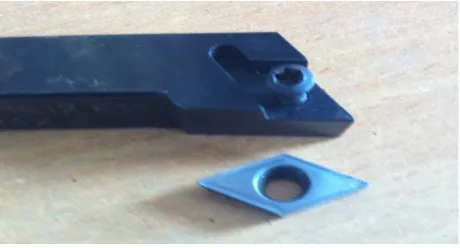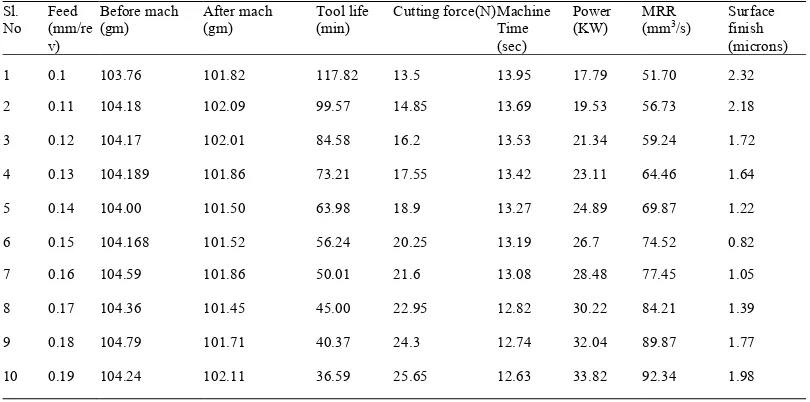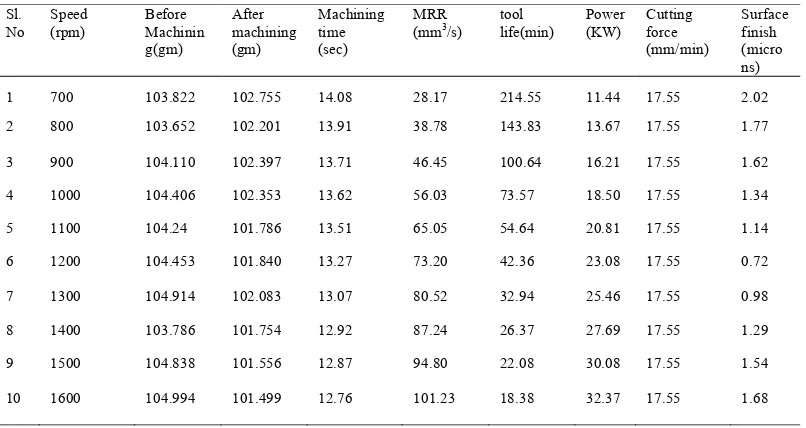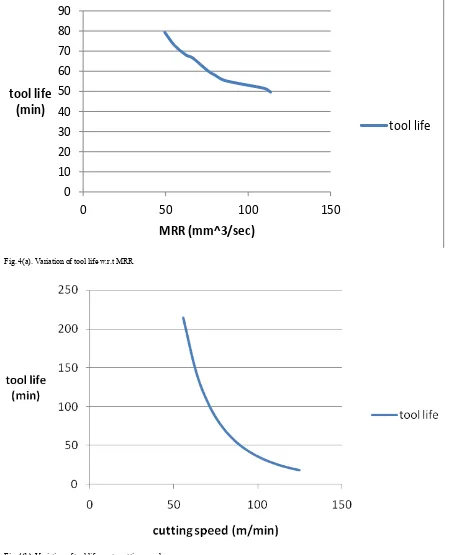Analysis of Tool Life during Turning Operation by Determining Optimal
Process Parameters
Article in Procedia Engineering · December 2014 DOI: 10.1016/j.proeng.2014.12.247
CITATIONS
3
READS
587
3 authors, including:
Some of the authors of this publication are also working on these related projects:
Single Stage Gas gunView project C. J Rao
Aditya Institute of Technology & Management
3 PUBLICATIONS 40 CITATIONS SEE PROFILE
Dr. Arun Tom Mathew
VIT University
33 PUBLICATIONS 73 CITATIONS SEE PROFILE
All content following this page was uploaded by C. J Rao on 16 December 2015.
Procedia Engineering 97 ( 2014 ) 241 – 250 Available online at www.sciencedirect.com
1877-7058 © 2014 Published by Elsevier Ltd. This is an open access article under the CC BY-NC-ND license (http://creativecommons.org/licenses/by-nc-nd/3.0/).
Selection and peer-review under responsibility of the Organizing Committee of GCMM 2014 doi: 10.1016/j.proeng.2014.12.247
ScienceDirect
12th GLOBAL CONGRESS ON MANUFACTURING AND MANAGEMENT, GCMM 2014
Analysis of Tool Life during Turning Operation by Determining
Optimal Process Parameters
C.J.Rao
a*
D.Sreeamulu
aArun Tom Mathew
baProfessor, Department of Mechanical Engineering, AITAM, Tekkali, AP, INDIA-532201
aAssociate Professor, Department of Mechanical Engineering, VIT, Vellore, Tamilanadu, INDIA-632014
Abstract
In any metal cutting operation the features of tools, input work materials, machine parameter settings will influence the process efficiency and output quality characteristics. A significant improvement in process efficiency may be obtained by process parameter optimization that identifies and determines the regions of critical process control factors leading to desired outputs or responses with acceptable variations ensuring a lower cost of manufacturing. For turning process, the cutting conditions i.e. Speed, Feed and Depth of cut plays an important role in the efficient use of a machine tool.
In order to determine the optimum cutting conditions, one has to estimate the tool life and cutting forces with a reasonable degree of accuracy since many of the constraints those are applying on a process are influenced by these parameters. For a practical machining situation, since no adequate machining theory is available to predict the tool life and cutting forces, one is compelled to rely on empirical equations to predict these parameters. However, these empirical equations involve a number of constants which are not readily available. Hence this Paper proposes an alternative approach to determine the optimal process parameters used to predict cutting forces, tool life and surface finish
© 2014 The Authors. Published by Elsevier Ltd.
Selection and peer-review under responsibility of the Organizing Committee of GCMM 2014.
Keywords: Tool life, cutting speed, feed, depth of cut.
1.Introduction
Metal cutting is one of the important and widely used manufacturing processes in engineering industries. The study of metal cutting focuses on the features of tools, input work materials, machine parameters and output quality characteristics (or responses). A significant improvement in process efficiency may be obtained by process
* Corresponding author. Tel.:+919440416577;
E-mail address: [email protected]
© 2014 Published by Elsevier Ltd. This is an open access article under the CC BY-NC-ND license (http://creativecommons.org/licenses/by-nc-nd/3.0/).
parameter optimization that identifies and determines the regions of critical process control factors leading to desired outputs or responses with acceptable variations ensuring a lower cost of manufacturing. For a machining process such as turning, the cutting conditions like cutting speed, feed, depth of cut and cutting fluids plays an important role in the efficient use of a machine tool. For a practical machining situation, since no adequate machining theory is available to predict the tool life and cutting forces, one is compelled to rely on empirical equations to predict these parameters. However, these empirical equations involve a number of constants which are not readily available. Furthermore these constants depend on many factors thus requiring a huge amount of data for a general workshop situation and getting and managing such data is an extremely difficult task. Hence this paper proposes an alternative approach to predict cutting forces, tool life etc.
Nomenclature
D Depth of cut in mm F Cutting Force in N
K Specific cutting force in
N/mm
2 MRR Metal Removal Rate mm3/secn Taylor’s tool life exponent P Power required in KW S Feed in mm/rev T Machining Time in sec V Cutting Velocity in mm/sec
1.1.Tool life
Tool life generally indicates the amount of satisfactory performance or service rendered by a fresh tool or a cutting point till it is declared failed. The tool life with respect to R&D and Industry perspective can be defined as follows
x In R & D: Actual machining time (period) by which a fresh cutting tool (or point) satisfactorily works after
which it needs replacement or reconditioning. The modern tools hardly fail prematurely or abruptly by mechanical breakage or rapid plastic deformation. Those fail mostly by wearing process which systematically grows slowly with machining time. In that case, tool life means the span of actual machining time by which a fresh tool can work before attaining the specified limit of tool wear.
x
In industries or shop floor: The length of time of satisfactory service or amount acceptable outputprovided by a fresh tool prior to it is required to replace or recondition
.
1.2.Assessment of tool life
In R & D, tool life is always assessed or expressed by span of machining time (T) in minutes, whereas in industries tool life is assessed depending upon the situation, such as number of work pieces machined, total volume of material removed and total length of cut during machining [1] . Taylor’s has proposed a tool life equation by considering different machining parameters like Cutting Velocity, (V ), Feed, (S) and Depth of cut (D).
VTn = C
243
C.J. Rao et al. / Procedia Engineering 97 ( 2014 ) 241 – 250
and Depth of cut (D) also plays a role on tool life. By considering the effects of all those parameters, the Taylor’s tool life equation has been modified as
VTnFaDb= C
Where, T = tool life in minutes, C = constant depends on tool - work material and x, y, z are tool life exponents depending upon the tool - work materials and the machining environment. The values of the constants, C, n, a and b are available in Machining Data Handbooks or can be evaluated by machining tests.
2.Related Work
Literature on machining is huge and considerable amount of work has been done on analysis of tool life during machining. Most of the existing research focuses on influence of different parameters on tool life. Some literature related to the proposed works is given below.
Axinte et al. [2] in turning process, they proposed a methodology of evaluating those uncertainty components of a single cutting force measurement that are related to the contributions of the dynamometer calibration and the cutting process itself. On the basis of empirical model including errors from both the sources, the uncertainty for a single measurement of cutting force, and expressions for the uncertainty vs. cutting parameters are presented. For defined range of cutting parameters approach gives the possibility of evaluating cutting force uncertainty components, on the basis of few experiments.
Dahlman et al. [3] have conducted the study on the influence of rake angle, cutting speed and cutting depth on residual stresses in hard turning the results of their work shown that a greater negative rake angle gives higher compressive stresses and the compressive stresses increase with the increased feed rate. Zhou et al.[4] have investigated the effect of chamfer angle on the wear of PCBN cutting tool. They concluded that the chamfer angle has a great influence on the cutting force and tool life and all the three force components increase with an increase of the chamfer angle. The optimized chamfer angle, for the maximum tool life as suggested by their study, is 15°.
Chou and Song[5] have investigated the effects of tool nose radius on finish hard turning with ceramic tools. In their study, surface finish, tool wear, cutting forces, and, particularly, white layers were evaluated at different machining conditions. Their results shown that large tool nose radii not only give finer surface finish, but also considerable tool wear compared to small nose radius tools. Specific cutting energy also increases slightly with tool nose radius. They also have shown that large nose radius tools generate shallower white layers when cutting by worn tools. For new tools, small nose radius results in larger uncut chip thickness, and thus, induces deeper white layers. Endres and Kountanya [6] have reported the effects of comer radius and edge radius on tool flank wear. The results of their work shown the interaction of corner radius and edge radius and their effects on process performance, measured in terms of tool flank wear and forces. Finally they concluded that there is an advantage exists in using a larger corner radius when using a larger edge radius.
Huang and Liang [7] focused on the finish turning in which the applied feed rate and depth of cut are usually very small. They initially predicted the chip formation forces by transforming the 3-D cutting geometry into an equivalent 2-D cutting geometry and after that calculated the total 2-D cutting forces by ploughing effect mechanistic model and finally then 3-D cutting forces are estimated by a geometric transformation. Dahlman et al. [8] showed that rake inclination had the strongest influence on the residual stresses in turning. The residual stresses were measured by using the X-ray diffraction method in both speed and feed direction and concluded that greater negative rake angle gives higher compressive stresses and cutting depth does not affect residual stresses. Further it has been shown that compressive stresses become greater with increased feed rate.
model, an analysis of tool wear is also possible as it is directly related to cutting temperature, stresses and chip sliding velocity.
3.Proposed Work
This work proposes an experimental investigation of optimum cutting parameters to achieve a better tool life during turning operation. The cutting conditions i.e. speed, feed and depth of cut plays an important role in the efficient use of a machine tool. The tool life has been evaluated by varying the above said cutting conditions for different aluminium work pieces using tungsten carbide cutting tool on a CNC turning machine.
3.1 Cutting Tool and work material used
Besides the different variety of tools, a tungsten carbide tool shown in Fig. 1 has been chosen in this work. The tungsten carbide is an inorganic chemical compound (specifically, a carbide) containing equal parts of tungsten and carbon atoms. Colloquially, tungsten carbide is often simply called carbide. In its most basic form, it is a fine gray powder, but it can be pressed and formed into shapes for use in industrial machinery, tools, abrasives, as well as jewelry. Tungsten carbide is approximately three times stiffer than steel, with a Young's modulus of approximately 550 GPa and is much denser than steel or titanium.
Fig. 1. Tungsten Carbide tool
The CNC machine used in our experimentation is a MTAB CNC turning with Fanuc controller. This Machine is best suitable for machining aluminium ingots, hence we have chosen an aluminium as work material for our experimentation. The different work piece materials tested during experimentation is shown in Fig. 2.
245
C.J. Rao et al. / Procedia Engineering 97 ( 2014 ) 241 – 250
3.2 Experimentation
Different aluminium rods has been taken and machined on CNC machine by varying different parameters. The machining process of different aluminium rods has shown in Fig. 3.
Fig. 3. Machining on MTAB CNC Machine
3.3 Evaluation of the parameters during turning operation
The Expanded taylor’s tool life equation used in evaluating the parameters i.e. VTnFaDb=C. The exponents a and b
are to be determined experimentally for each combination of cutting conditions. In practice typical values for carbide tools and aluminium as work piece are n=0.33, a=0.6, b=0.15 and c=80.
VT0.33 F0.6 D0.15=80 (1)
The mathematical formulas used in calculating different parameters are as follows
(i) Power Required: P= (K x D x V x F)/ (60*1000)
(ii) Cutting Force: F = (KxDxF)
(iii)Metal removal Rate (MRR): The MRR is Volume removed in machining Process per Machining Time.
Where Volume removed is = (Initial weight of work piece - Final weight of work piece)/density of work piece
4. Results and Analysis
Table 1. Results against varying depth of cut (Speed = 1000RPM, Feed=0.13mm/rev)
247
C.J. Rao et al. / Procedia Engineering 97 ( 2014 ) 241 – 250
Table 3. Results against varying spindle speed (Feed=0.13mm/rev, Depth of Cut=0.3mm)
4.1 Effect of tool life w.r.t MRR, cutting speed and cutting force
The data obtained form the experimentation and calculation i.e. the variation of tool life w.r.t MRR, cutting speed and cutting force are shown in Tables-4, Tables-5 & Tables-6. The relation between MRR, Cutting speed and Cutting force with tool life has been shown in Fig. 4 graphically by using the data given in above tables. The graphs shows that the tool life is degresing gradually as MRR, Cutting speed and cutting force increases and it may result in the damage of cutting tool.
Table 4. Tool life for different MRR
Table 5. Tool life for different Cutting speed
0
10
20
30
40
50
60
70
80
90
0
50
100
150
tool life
(min)
MRR (mm^3/sec)
tool life
Fig. 4(a). Variation of tool life w.r.t MRR
249
C.J. Rao et al. / Procedia Engineering 97 ( 2014 ) 241 – 250
Fig. 4(c). Variation of tool life w.r.t cutting force
4.2 Optimum process parameters w.r.t surface finish
The optimum process parameters in the three stages w.r.t surface finish are as follows.
x Varying depth of cut and keeping other two parameters i.e. speed and feed as constant, it was found that the optimal point is at 0.4mm depth of cut where the surface finish is 1.02 microns, tool life 66.20min and the cutting force 23.4N.
x Varying feed and keeping other two parameters i.e. speed and depth of cut as constant, it was found that the optimal point is at 0.15mm/rev feed. Where the surface finish is 0.82 microns, tool life 56.24min and the cutting force 20.25N.
x Varying speed and keeping other two parameters i.e. feed and depth of cut as constant, it was found that the optimal point is at 1200rpm speed. Where the surface finish is 0.72 microns, tool life is 42.36.min and the cutting force 17.55N.
Table-7: Optimum process parameters against surface finish
After successful execution of the MATLAB program, the optimum process parameters obtained are 0.33 (DOC), 1066 (Speed) and 0.14 (Feed).
5.Conclusion
In this work aluminium is taken as a work material and tungsten carbide as tool material. By varying the different parameters like depth of cut, speed and feed at different conditions the tool life, surface finish, cutting force and other parameters were calculated. The results showed that the tool life is decreasing as the cutting force, MRR and cutting speed increases. The MATLAB results showed that the best surface finish is approximately equal to average of three stages output. The optimum process parameters obtained from MATLAB program will give a reasonable surface finish with better life.
References
[1] PNRAO , “Metal cutting and machine tools”, Text book of Tata Mech Grawhil publications, Vol.2, 3rd Edition, 2013.
[2] D.A. Axinte, W. Belluco, L. De Chiffre ,“Evaluation of cutting force uncertainty components in Turning” International Journal of Machine Tools & Manufacture 41, 2001, pp. 719–730,.
[3] N.R. Dharb, M.M.A. Khan, M.A.H. Mithu., “Effects of minimum quantity lubrication on turning AISI 9310 alloy steel using vegetable oil-based cutting fluid” Journal of Materials Processing Technology, 209, 2009,pp. 5573–5583
[4] Babur Ozcelik, Emel Kuram, Erhan Demirbas, M. Huseyin Cetin., “Evaluation of vegetable based cutting fluids with extreme pressure and cutting parameters in turning of AISI 304L by Taguchi method” Journal of Materials Processing Technology 209, 2009,5573– 5583
[5] M.D.Abad , M.M.Abdelhameed, M.A. ElHakim, M.A.Shalaby , S.C.Veldhuis “ Wear behavior of some cutting tool materials in hard turning of HSS “ Tribology International 44, 2011, pp.1174–1181
[6] M.Sortino G. Totis “Development of a modular dynamometer for triaxial cutting force measurement in turning” International Journal of Machine Tools & Manufacture, 2011.
[7] Yong Huang, Steven Y. Liang, “Force modeling in shallow cuts with large negative rake angle and large nose radius tools—application to hard turning” Int J Adv Manuf Technol 22 ,2003, pp. 626–632,.
[8] Patrik Dahlman, Fredrik Gunnberg, Michael Jacobson, “The influence of rake angle, cutting feed and cutting depth on residual stresses in hard turning” Journal of Materials Processing Technology 147,2004, pp. 181–184.
[9]Yung-Chang Yen, Anurag Jain, Taylan Altan , “A finite element analysis of orthogonal machining using different tool edge geometries” Journal of Materials Processing Technology 146, 2004, pp. 72–81.





